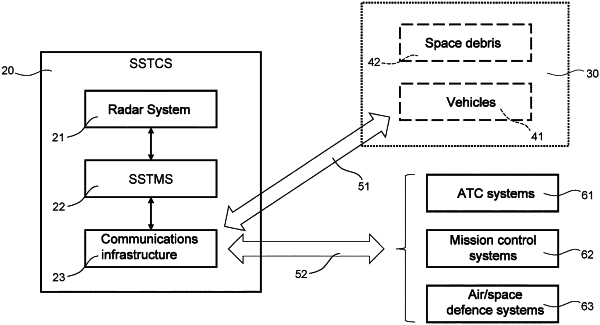| CPC G08G 5/045 (2013.01) [B64G 1/242 (2013.01); B64G 3/00 (2013.01); G01S 13/726 (2013.01); G01S 13/933 (2020.01); G08G 5/0008 (2013.01); G08G 5/0021 (2013.01); G08G 5/0043 (2013.01)] | 9 Claims |

|
1. A suborbital space traffic control system, comprising:
a radar system configured to
monitor a predetermined suborbital region comprised between a first predetermined altitude of 20/22 km and a second predetermined altitude of 120/150 km from earth's surface, and
detect and track vehicles and space debris in said predetermined suborbital region;
a suborbital space traffic monitoring system; and
a communications infrastructure configured to allow the suborbital space traffic monitoring system to carry out
ground-air and air-ground communications with the vehicles in the predetermined suborbital region, and
ground-ground communications with other ground systems;
wherein the radar system includes:
a primary radar sensor equipped with an electronically scanned array antenna;
an ADS-B receiver based on Automatic Dependent Surveillance-Broadcast technology; and
a radar processing unit, which is connected to the primary radar sensor and to the ADS-B receiver to receive data therefrom, and is configured to
detect and track the vehicles and the space debris in the predetermined suborbital region on the basis of the data received from said primary radar sensor and from said ADS-B receiver,
generate tracking data related to said detected and tracked vehicles and space debris, and
provide the suborbital space traffic monitoring system with said tracking data;
wherein said suborbital space traffic monitoring system is configured to:
monitor, on the basis of the tracking data received from the radar system, trajectories of the vehicles and of the space debris in the predetermined suborbital region by using one or more predetermined machine-learning techniques to detect
one or more potential collision situations between/among two or more of the vehicles in the predetermined suborbital region,
one or more potential collision situations between/among one or more pieces of the space debris and one or more of the vehicles in the predetermined suborbital region, and
one or more explosions of one or more vehicles in the predetermined suborbital region;
if it detects, on the basis of the monitored trajectories, a potential collision situation between/among two or more first vehicles in the predetermined suborbital region, transmit corresponding alarm messages to said first vehicles;
if it detects, on the basis of the monitored trajectories, a potential collision situation between/among one or more pieces of the space debris and one or more second vehicles in the predetermined suborbital region, transmit one or more corresponding alarm messages to said second vehicle(s);
if it detects a first collision between/among two or more third vehicles in the predetermined suborbital region,
operate the primary radar sensor to detect and track debris produced by said first collision, and
monitor trajectories of said debris produced by said first collision by using the predetermined machine-learning technique(s);
if it detects a second collision between/among one or more pieces of the space debris and one or more fourth vehicles in the predetermined suborbital region,
operate the primary radar sensor to detect and track debris produced by said second collision, and
monitor trajectories of said debris produced by said second collision by using the predetermined machine-learning technique(s);
if it detects an explosion of a fifth vehicle in the predetermined suborbital region,
operate the primary radar sensor to detect and track debris produced by said explosion, and
monitor trajectories of said debris produced by said explosion by using the predetermined machine-learning technique(s);
communicate with the vehicles in the predetermined suborbital region through the primary radar sensor by using a technology based on/derived from L-band Digital Aeronautical Communication System technology; and
provide payload management via a satellite connection, wherein a payload is extracted based on Ka bands, L bands, or a combination thereof from the satellite connection.
|